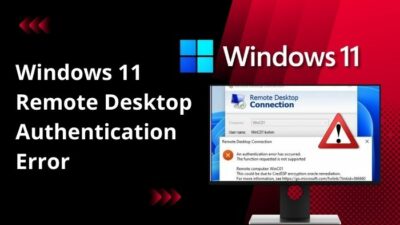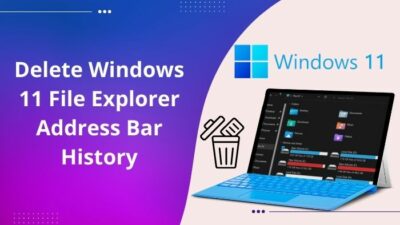You might be wondering if the fast startup is good or bad for your Windows 11 computer.
At first, it seems confusing whether you should turn on or off fast startup on your Windows 11 computer.
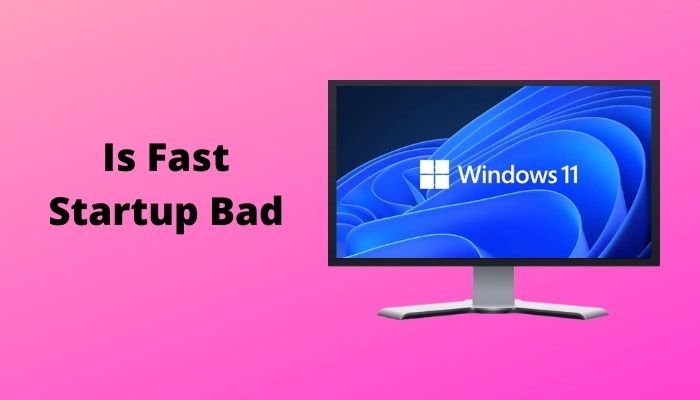
As a Windows and tech specialist, I will discuss the advantages and disadvantages of the Windows fast startup. Also, I will show you some tested and effective methods to enable or disable the fast startup on your computer.
So, Is fast startup bad?
Keep reading the whole post to know about the details of the fast startup.
So, let’s get started without further delay.
How Does Fast Startup Work On Windows
Fast startup is a technique for speeding up your computer’s startup time, and it will save time waiting for your computer to boot up.
Fast startup, often known as fast boot. Fast Startup in Windows is a function that allows you to start your computer faster than usual.
Nowadays, most modern computers have it enabled by default that is fast startup compatible. This feature is only available on computers that have the Hibernate feature.
The fast startup or fast boot process works opposite of the regular shuts of the process. When the computer is shutting down normally, the system closes all the running programs then shuts down.
The fast boot process works similarly to the hibernate process. When the fast startup is turned on your system, Windows saves all the user’s data and keeps running the system sessions before shutting down the PC and begins work from where users left off on the next startup.
If the fast startup is not enabled by default on your system, you can easily allow it to speed up your Windows boot time.
Follow our guide on How to Boot to Safe Mode in Windows 11.
Is Fast Startup Bad For Your PC?
The answer is not at all because it depends on the uses. Sounds great, right? That’s correct.
Windows keeps all the remaining boot information before shutting down the system if the fast boot is enabled. This feature keeps running Windows kernel to keep the system sessions active.
The Fast startup helps begin work from where users left off on the next startup instead of starting everything from scratch.
The Fast startup helps to speed up your computer’s startup time and save users time while your computer boots up.
Sometimes, the fast startup is terrible. When the Windows system installs the update, it requires a fresh restart. But, the fast startup stops fresh restart to your system. For this reason, it occurs problem.
Another problem is that the fast boot feature does not allow you to use dual boot though your system already has a dual boot because this feature disabled the delayed start function, which prevents users from selecting the dual boot option.
So, the fast startup or fast boot feature has both good and bad sides. If your system startup time is slower, you can enable and use the fast startup to increase your boot speed if your system supports fast boot.
On the other hand, if you are facing any problem in your system using the fast startup, then you can disable it at any time to solve your problem.
Check our exclusive tutorial on How to Fix Blue Screen on Windows 11.
How To Enable Fast Startup On Windows 11
Enable the fast startup on your Windows 11 system can boost your windows startup time if your system supports the fast startup feature.
If your system startup takes a longer time, then the fast startup feature can help to speed up your computer’s startup time and save your time.
This section will show you some tested methods to enable the fast startup feature. The process of allowing a fast startup feature is straightforward on your Windows 11 system.
So, to enable the fast boot, follow the instruction carefully.
So, the superfetch service is using a lot of CPU? Check out how to disable SuperFetch on Windows 11.
Here are the steps to enable the fast startup on Windows 11:
1. Use Command Prompt
When you want to enable the fast startup feature, you first need to enable the hibernate feature because the fast startup feature is only available on computers with the Hibernate feature.
If hibernate is not enabled on your system, follow these steps to enable the hibernate using Command Prompt:
- Press the Windows Key on your keyboard to open the Start menu.
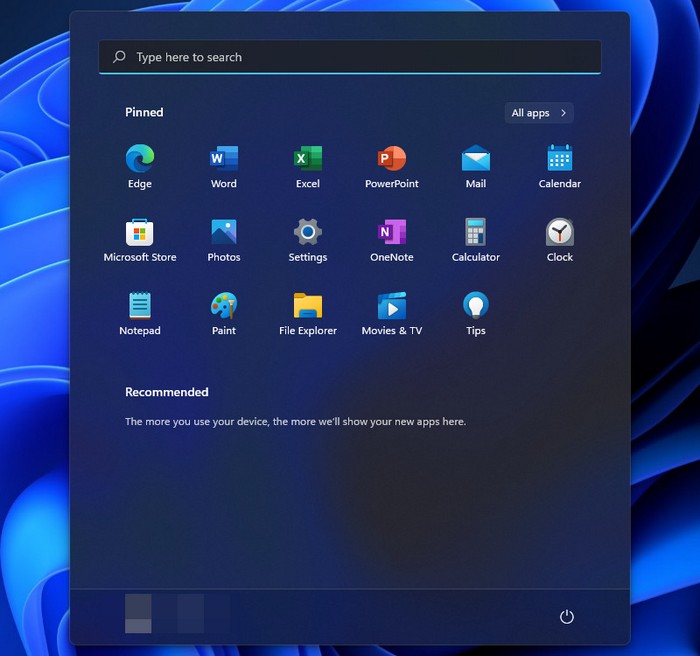
- Click on the Start icon on the left side of the taskbar to open the Start menu.
- Click on the search bar and type cmd.
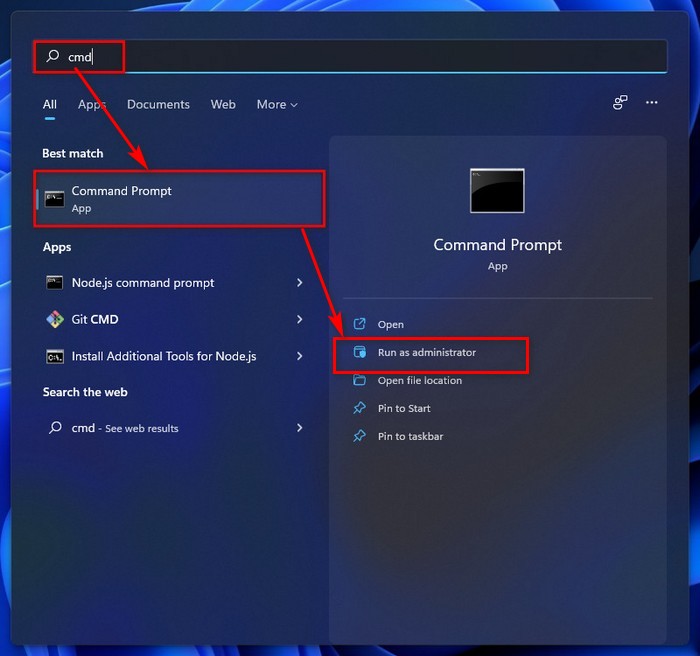
- Click on Run as administrator to open the Command Prompt with admin privileges.
- Type Powercfg -h on command and hit the Enter button.
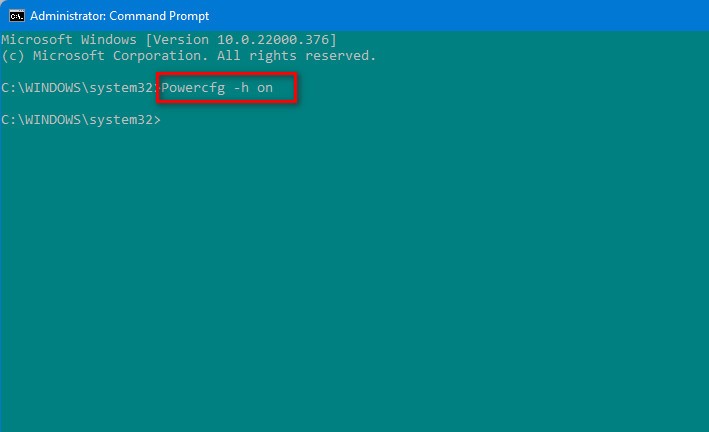
- Hibernate feature is enabled and appears on the Control Panel.
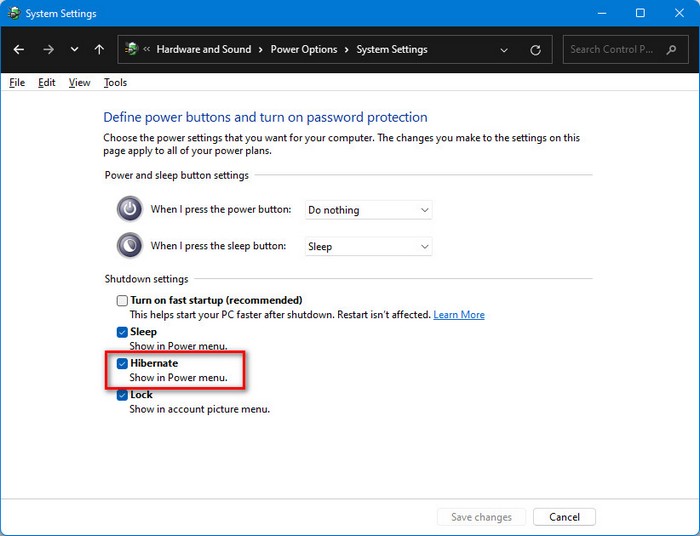
After enabling hibernate feature, you can now turn on the fast startup feature on the Control Panel.
So, follow the next method to enable the fast startup feature on your Windows 11 system.
Check our latest post on how PC won’t go to sleep mode in Windows 11.
2. Use Control Panel
The first method to enable the fast startup feature is to use the system Control Panel. Using the Control Panel is a straightforward method.
Follow the steps below to enable the fast startup using the control panel:
- Press the Windows Key on your keyboard to open the Start menu.

- Click on the Start icon on the left side of the taskbar to open the Start menu.
- Type control panel and click on the search result to open the Control Panel.
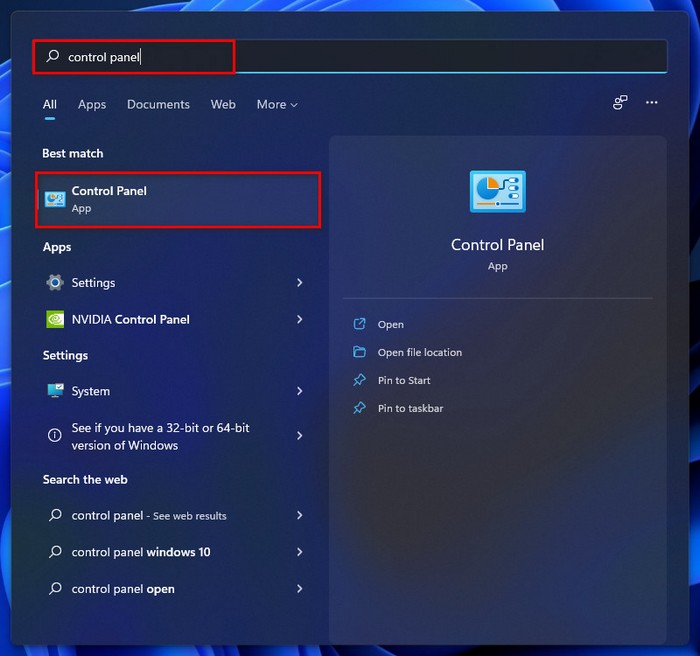
- Make sure your Control Panel is viewed by Category.
- Select the Hardware and Sound tab at the left side of the window.
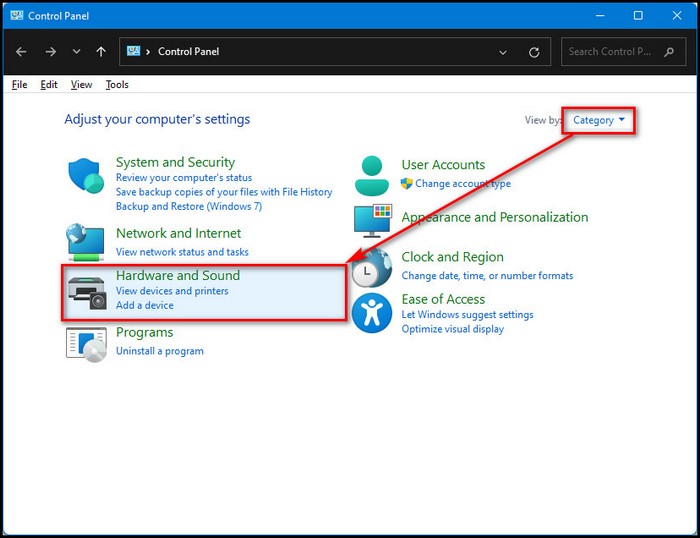
- Click on the Change what the power buttons do under the Power Options.
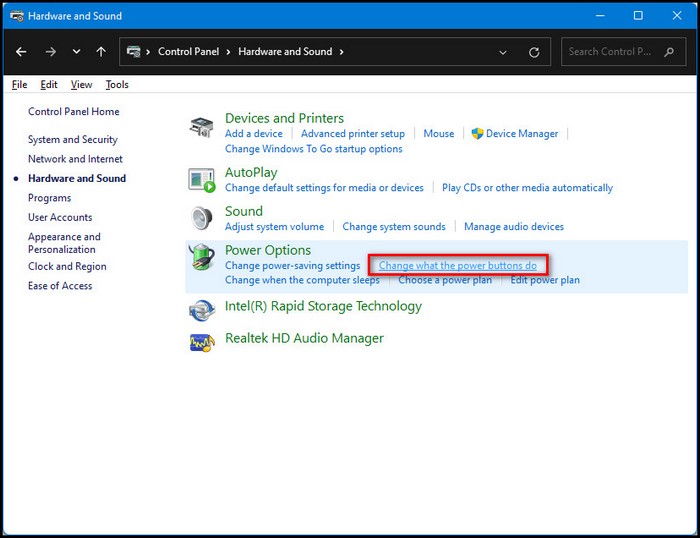
- Click on the Change settings that are currently unavailable.
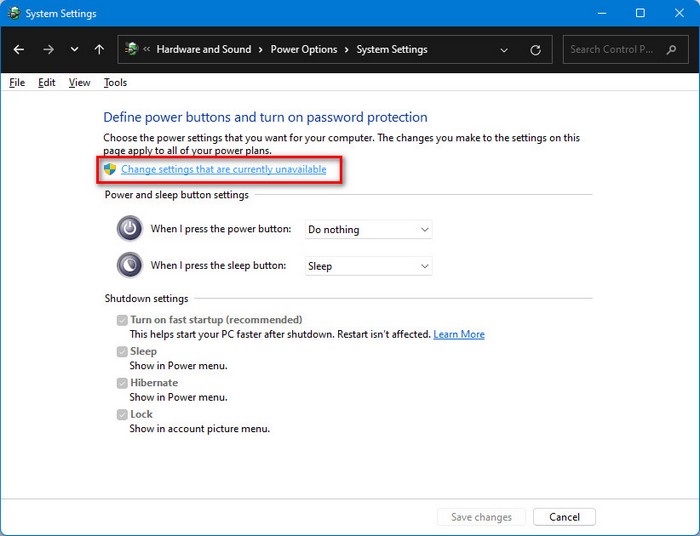
- Check the Turn on fast startup (recommended) box under the Shutdown settings.
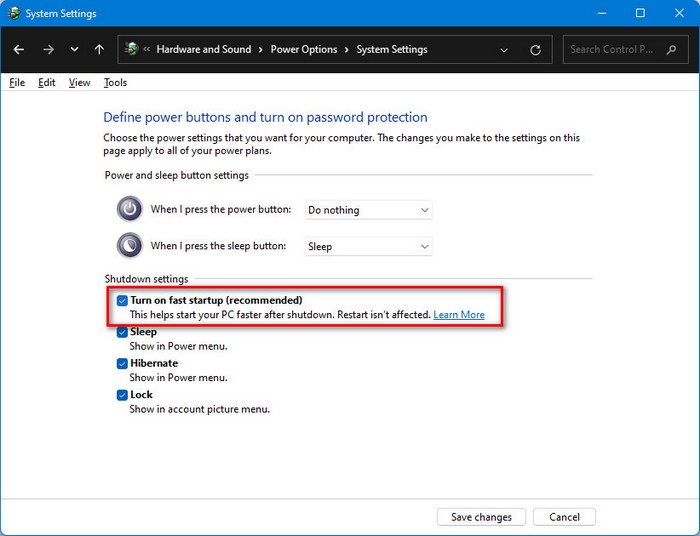
- Click on the Save changes button to apply the changes.
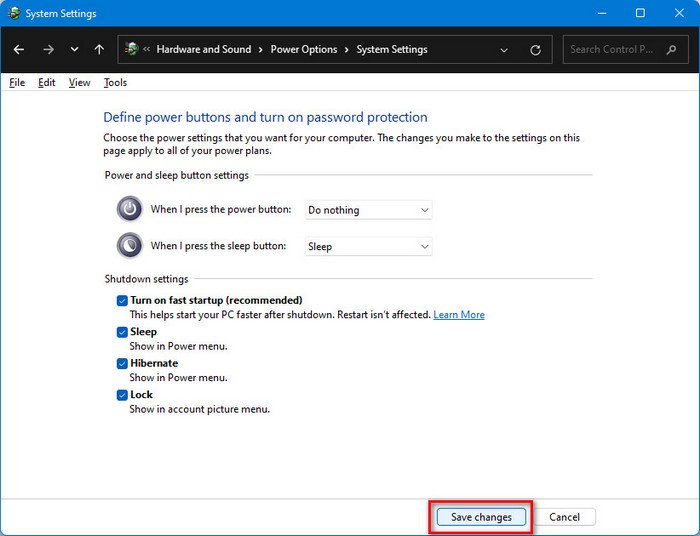
- Restart your computer to apply the changes entirely.
Check out our expert-recommended guide on How To Enable Telnet On Windows 11.
How To Disable Fast Startup On Windows 11
Sometimes, the fast startup is terrible. When the Windows system installs the update, it requires a fresh restart. But, the fast startup stops fresh restart to your system.
Also, the fast boot feature does not allow users to use dual boot because this feature disabled the delayed start function, which prevents users from selecting the dual boot option.
If you are facing any problem in your system using the fast startup, then you can disable it at any time to solve your problem.
Here are the steps to disable the fast startup on Windows 11:
1. Use Control Panel
The first method to disable the fast startup feature is to use the system Control Panel. Using the Control Panel is a straightforward method.
Follow the steps below to disable the fast startup using the control panel:
- Press the Windows Key on your keyboard to open the Start menu.

- Click on the Start icon on the left side of the taskbar to open the Start menu.
- Type control panel and click on the search result to open the Control Panel.

- Make sure your Control Panel is viewed by Category.
- Select the Hardware and Sound tab at the left side of the window.

- Click on the Change what the power buttons do under the Power Options.

- Click on the Change settings that are currently unavailable.

- Uncheck the Turn on fast startup (recommended) box under the Shutdown settings.
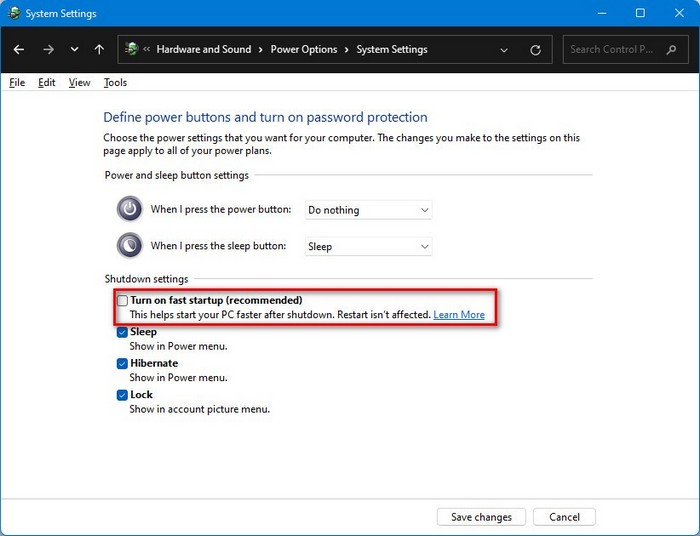
- Click on the Save changes button to disable the fast startup.
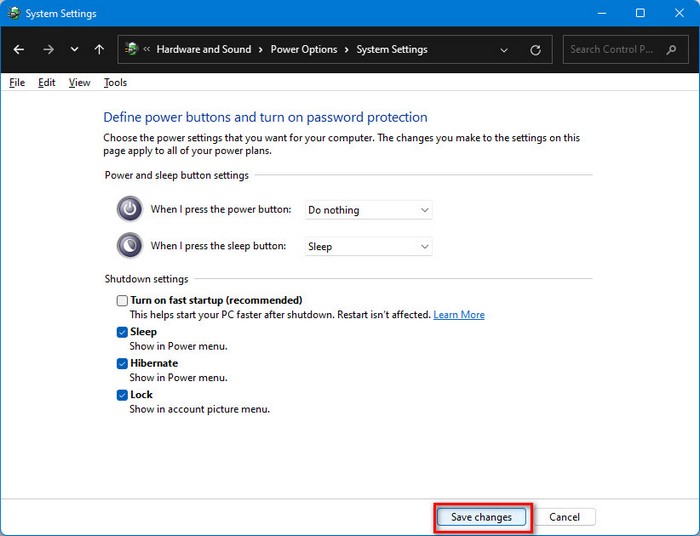
2. Use Command Prompt
Another way to disable the fast startup feature is to disable the hibernate feature using the command prompt. If you disable hibernate feature, the fast startup is automatically disabled.
Follow these steps to disable the fast startup using Command Prompt:
- Press the Windows Key on your keyboard to open the Start menu.

- Click on the Start icon on the left side of the taskbar to open the Start menu.
- Type cmd and click on the search bar.
- Click on Run as administrator to open the Command Prompt with admin privileges.

- Type Powercfg -h off command and hit the Enter button.
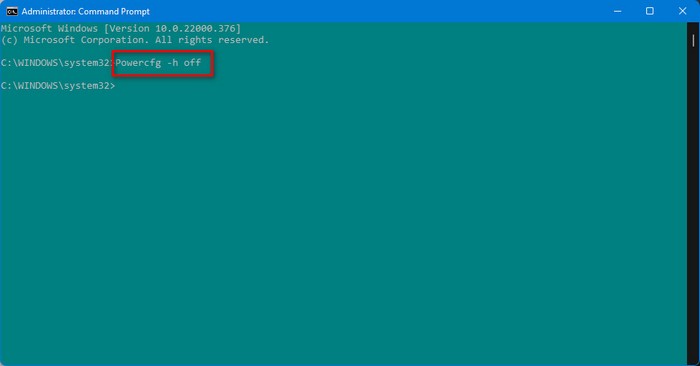
- Hibernate feature is disabled successfully.
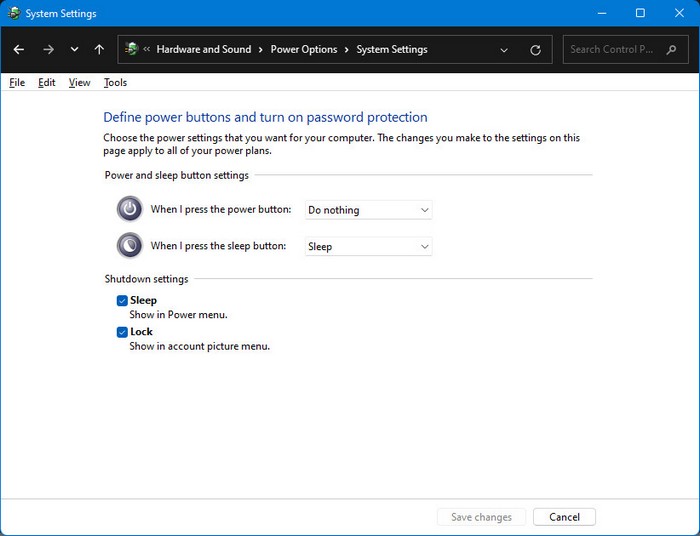
After disabling the hibernate feature, the fast startup feature is automatically disabled and disappears on the Control Panel.
Have some time to spare? Check out our latest fix for Bluetooth Toggle Missing On Windows 11.
Final Thoughts
Fast startup is a helpful technique for speeding up your computer’s startup time. Windows keeps all the remaining boot information before shutting down the system and helps begin work from where users left off on the next startup if the fast boot is enabled.
This article discusses how the fast startup feature works and the advantage and disadvantages of using the fast startup. I also describe two tested and effective methods to enable and disable the fast startup on Windows 11 system.
If you find this post helpful, do like, comment, share it with your friends, and see other posts if you want to know other related topics.



